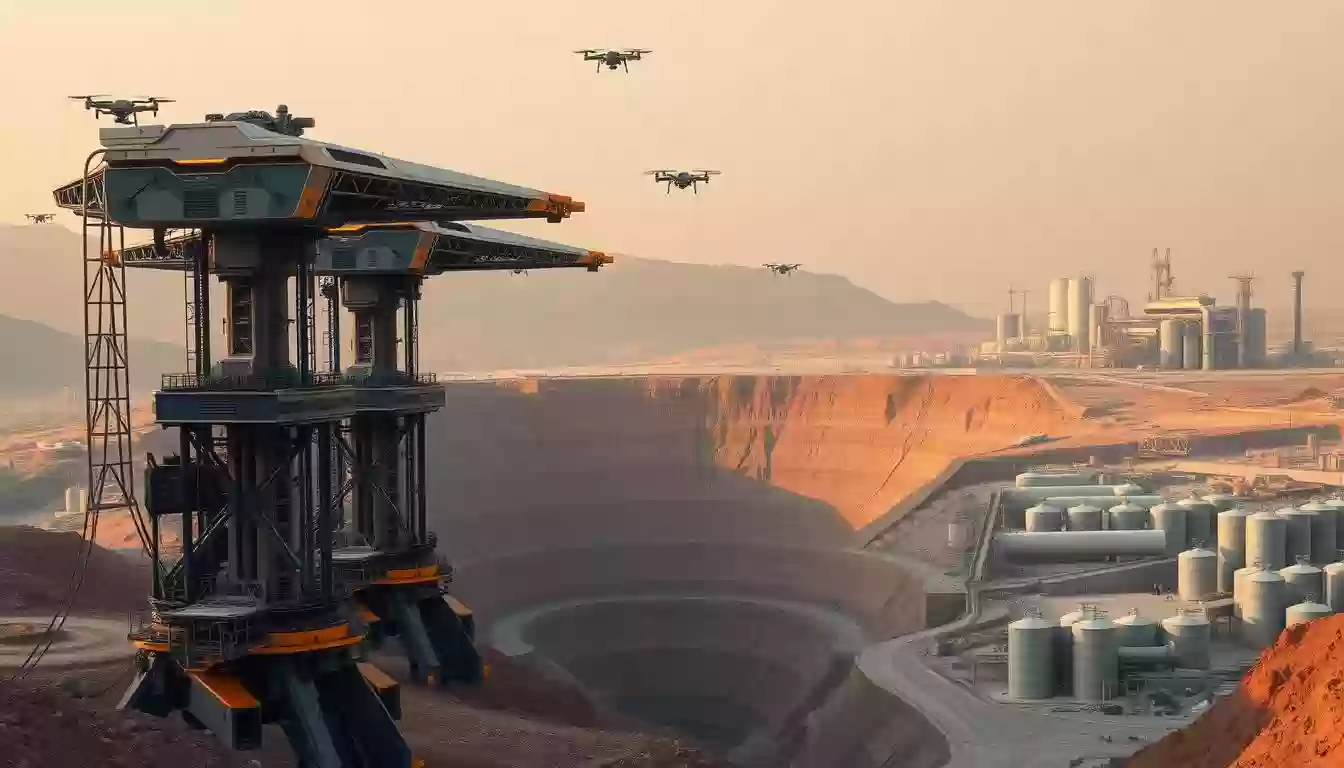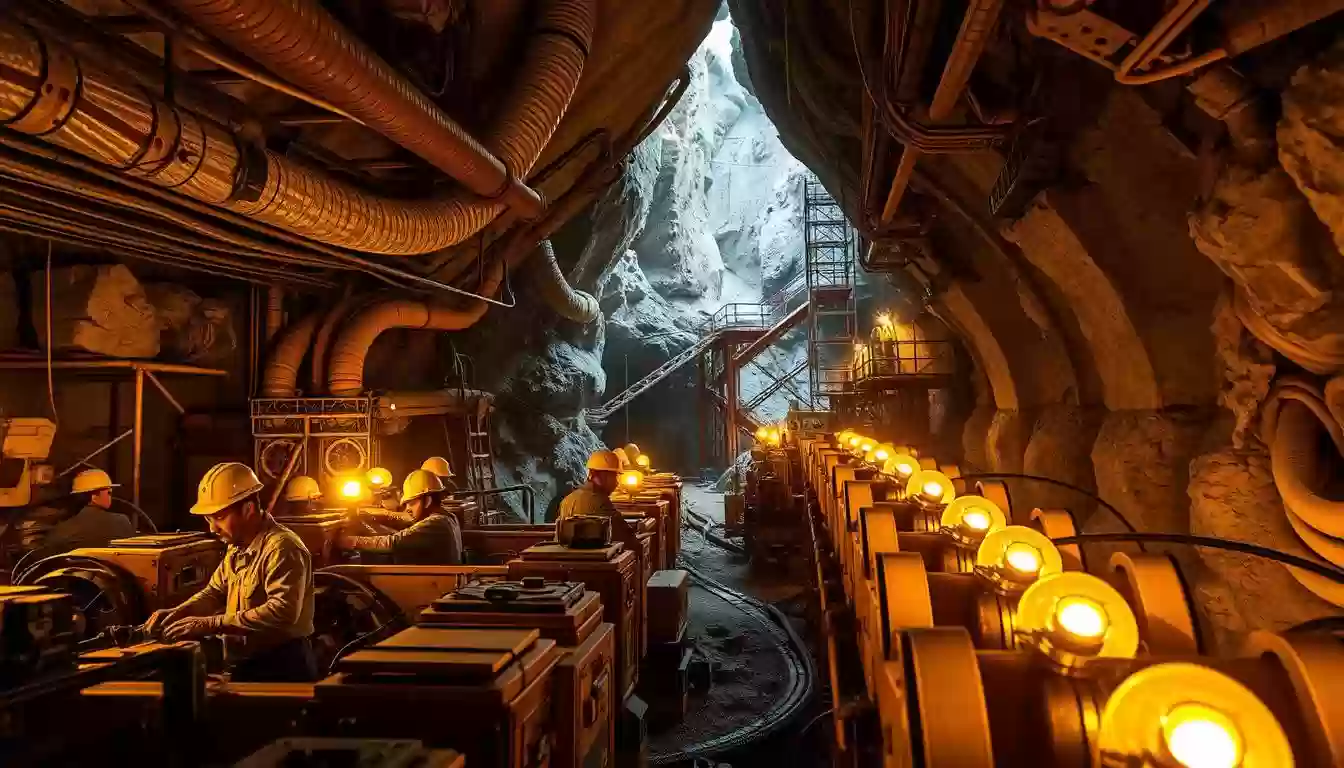Exploring the Latest Mining Trends: Insights for 2025
 04 Mar 25
04 Mar 25
The mining industry is at a crossroads, with significant shifts in technology and sustainability practices shaping its future. As we step into 2025, understanding these emerging trends is crucial for companies aiming to stay competitive and meet global demands.
Industry leaders like Rio Tinto and BHP are setting benchmarks with ambitious emission reduction targets and AI integrations. These strategic moves highlight how the sector is evolving to address environmental challenges while optimizing operations.
This article delves into a mix of technology-driven improvements and global market challenges. By focusing on real data, such as emission targets and AI adoption, we provide actionable insights for managers and decision-makers.
With detailed management strategies, we explore how to balance sustainability efforts with cost savings. Whether you're a seasoned professional or new to the industry, this guide offers a clear roadmap for navigating the complexities of modern mining.
Stay ahead with the latest insights and discover how these industry trends will shape future investments and operations.
Industry Overview and Global Shifts
The mining industry is undergoing significant transformations as global market dynamics and economic challenges reshape its landscape. Fluctuating commodity prices and supply chain reconfigurations are pressing issues that companies must navigate to remain competitive.
Global Market Trends and Economic Challenges
Recent data shows that falling commodity prices have impacted profit margins across the sector. For instance, major companies like BHP and Rio Tinto are adapting their strategies to address these economic pressures. Supply chain reconfigurations are also a focal point, as industries seek to enhance resilience and reduce dependency on unstable regions.
Geopolitical Impacts on the Mining Industry
Geopolitical tensions in Africa and Asia have introduced new layers of complexity. China's dominance in critical minerals has shifted global market dynamics, influencing commodity prices and availability. This has prompted companies to diversify their supply chains and explore new partnerships to mitigate risks.
Tracking these emerging trends is crucial for informed decision-making. By leveraging real-world data, companies can anticipate challenges and align their operational strategies with market demands. Supply chains play a pivotal role in mitigating risks and fostering growth, making them a cornerstone of modern mining operations.
Technological Innovation and Digital Transformation in Mining
Digital transformation is reshaping the mining industry, driving efficiency and safety through cutting-edge technologies. Companies are embracing innovation to stay competitive and meet growing demands.
Digital Innovation and AI Integration
Artificial intelligence is revolutionizing traditional mining operations. Rio Tinto uses AI for mapping projects, enhancing accuracy and speed. Digital twin technology creates virtual models of mines, optimizing production processes and predicting potential issues before they arise. Machine learning and advanced sensor networks further refine operations, ensuring resources are used efficiently.
These technologies enable real-time data analysis, allowing for informed decision-making and process optimization. Mining companies are investing heavily in these solutions to improve efficiency and reduce costs.
Advancements in Automation and Robotics
Automation and robotics are transforming mining operations. Autonomous trucks and robotics handle drilling and hauling, enhancing safety and efficiency. Predictive analytics reduces downtime and operational costs, while advanced systems improve resource utilization.
These innovations are crucial for meeting increasing demand in a competitive market. By leveraging technology, companies can achieve operational excellence and sustainable growth.
Incorporating Latest Mining Trends: Emission Reductions, AI, and Automation
The mining sector is committed to a sustainable future, with companies prioritizing emission reductions and leveraging advanced technologies. Leaders like BHP and Rio Tinto are setting ambitious targets, such as BHP's 30% reduction by 2030 and Rio Tinto's net-zero goal by 2050. These strategies highlight the industry's dedication to environmental responsibility while maintaining operational efficiency.

AI and automation are pivotal in this transformation. Autonomous trucks and predictive analytics optimize operations, reducing emissions and enhancing safety. For instance, Rio Tinto's autonomous fleet has significantly lowered energy use, aligning with global sustainability efforts.
| Company | Target | Strategy | Investment |
|---|---|---|---|
| BHP | 30% reduction by 2030 | Autonomous operations, supply chain optimization | $5-6 billion |
| Rio Tinto | Net-zero by 2050 | AI integration, decarbonization projects | $5-6 billion |
These initiatives not only reduce carbon footprints but also strengthen supply chains, ensuring a reliable transition to renewable energy. The mining industry's embrace of technology underscores its role in sustainable development and resource efficiency.
Evolving Supply Chains and Critical Mineral Demands
The global demand for critical minerals is surging, driven by the urgent need for energy transition technologies. As the world shifts towards renewable energy sources and electric vehicles, the mining industry must adapt to meet the growing requirements for lithium, cobalt, and rare earth elements.
Battery Minerals and Lithium Recovery Trends
Battery minerals are at the forefront of this transformation. Lithium, in particular, is experiencing unprecedented demand growth. GlobalData forecasts a 25% increase in lithium recovery projects by 2026, supported by rising investments in electric vehicle infrastructure. Companies are also innovating in lithium recovery techniques, with over 150 patent filings in 2024 alone.
Environmental regulations are pushing the industry towards more sustainable processing methods. For instance, hydrometallurgical techniques are gaining traction as they reduce water usage and lower emissions compared to traditional methods. This shift not only meets regulatory requirements but also aligns with broader sustainability goals.
Restructuring Global Critical Mineral Supply Chains
Supply chain reconfiguration is essential to address cost challenges and meet the soaring demand for critical minerals. Companies like Tesla and Ford are leading this charge by diversifying their supply sources and investing in local processing capabilities. This strategy not only enhances supply chain resilience but also reduces dependency on imports.
GlobalData highlights that over 70% of lithium processing capacity is currently concentrated in China. To mitigate risks, countries like the U.S., Australia, and Canada are forming strategic partnerships to develop domestic production and reduce reliance on foreign suppliers. These collaborations are crucial for ensuring long-term stability in the supply of critical minerals.
| Company | Lithium Recovery Strategy | Investment | Production Target |
|---|---|---|---|
| Tesla | Direct lithium extraction from brine | $2.5 billion | 50,000 tonnes/year by 2027 |
| Ford | Recycling and urban mining | $1.8 billion | 30,000 tonnes/year by 2028 |
These efforts underscore the importance of robust supply chain management in navigating the complexities of the energy transition. By integrating innovative recovery techniques and diversifying supply sources, the industry can ensure a stable and sustainable flow of critical minerals.
Enhancing Productivity and Cost-Efficiency in Mining Operations
The mining industry is increasingly focused on smarter operations to enhance productivity and reduce costs. By integrating advanced technologies and sustainable practices, companies are achieving significant efficiency gains while minimizing environmental impact.
Optimizing Operational Processes through Technology
Real-time data analytics and digital twin technology are transforming mining operations. These tools enable companies to monitor and optimize processes in real-time, reducing downtime and improving resource utilization. For example, BHP has implemented digital twins to simulate mining operations, leading to improved planning and reduced costs.
| Company | Technology | Investment | Outcome |
|---|---|---|---|
| BHP | Digital Twins | $1.2 Billion | 20% Reduction in Operational Costs |
| Anglo American | Predictive Analytics | $800 Million | 15% Increase in Resource Utilization |
These technologies not only enhance efficiency but also contribute to sustainability by optimizing resource use and reducing waste.
Integrating Sustainable Practices and Innovation
Sustainable practices are key to long-term cost efficiency. Companies are investing in renewable energy and circular economy models to reduce their environmental footprint. For instance, Anglo American has adopted renewable energy sources, lowering emissions and operational costs.
| Practice | Environmental Impact | Economic Benefit |
|---|---|---|
| Renewable Energy | Reduced Greenhouse Gas Emissions | Lower Energy Costs |
| Circular Economy | Extended Material Life | Reduced Waste and Costs |
These strategies not only meet environmental goals but also improve a company's bottom line.

By combining technological innovation with sustainable practices, the mining industry is achieving productivity gains and cost reductions. These advancements ensure that companies remain competitive while contributing to a more sustainable future.
Conclusion
The mining industry stands at a pivotal juncture, navigating a complex interplay of technological advancements, market dynamics, and sustainability goals. Key trends such as AI integration, automation, and emission reductions are reshaping operations, enabling companies to address environmental challenges while enhancing efficiency.
Strategic investments in digital transformation and supply chain realignments are critical for overcoming global challenges. For instance, industry reports highlight how companies like BHP and Rio Tinto are setting ambitious emission targets, leveraging AI and automation to optimize operations and reduce costs.
The surge in demand for critical minerals like lithium underscores the need for sustainable processing methods and diversified supply chains. By integrating innovative recovery techniques and investing in local processing, companies can enhance resilience and reduce dependency on unstable regions.
Looking ahead, the industry's ability to embrace continuous innovation and data-driven management will be pivotal. By aligning technological advancements with market trends and sustainability goals, mining companies can ensure long-term growth and contribute to a more sustainable future.
FAQ
How is the mining industry adapting to the energy transition?
The mining industry is playing a crucial role in the energy transition by focusing on critical minerals like lithium and cobalt. Companies are investing in sustainable practices and advanced technologies to reduce emissions and improve efficiency. This shift is essential for meeting global demand for clean energy solutions.
What technologies are transforming mining operations?
Technologies like automation, AI, and data analytics are revolutionizing mining. These tools enhance productivity, reduce costs, and improve safety. For example, autonomous equipment and predictive maintenance systems are becoming increasingly common in modern mining projects.
How are supply chains being impacted by critical mineral demand?
The demand for critical minerals, such as lithium and rare earth elements, is driving changes in global supply chains. Companies are diversifying their sources and investing in recycling technologies to ensure a stable supply of these essential resources.
What steps are mining companies taking to improve sustainability?
Mining companies are implementing sustainable practices like reducing water usage, minimizing waste, and adopting renewable energy sources. These efforts aim to lower the environmental impact of mining while maintaining efficiency and productivity.
How is the mining industry addressing safety challenges?
The industry is prioritizing safety through the adoption of advanced monitoring systems and automated equipment. These technologies help identify potential risks early and reduce accidents, creating a safer environment for miners.
What is the role of lithium in the energy transition?
Lithium is a key component in battery production, making it essential for the energy transition. As demand for renewable energy storage solutions grows, the mining industry is focusing on sustainable lithium extraction to support this growth.
How are mining companies balancing cost and efficiency?
By leveraging technology and optimizing operational processes, mining companies are achieving a balance between cost management and efficiency. This includes adopting energy-efficient equipment and streamlining supply chains.
What are the challenges facing the mining industry in 2025?
Key challenges include meeting the rising demand for critical minerals, reducing emissions, and adapting to regulatory changes. Companies are addressing these issues through innovation, collaboration, and sustainable practices.
How is the mining industry contributing to global sustainability goals?
The mining industry is supporting sustainability goals by providing the raw materials needed for clean energy technologies. Companies are also committing to net-zero targets and implementing environmentally responsible practices throughout their operations.





























